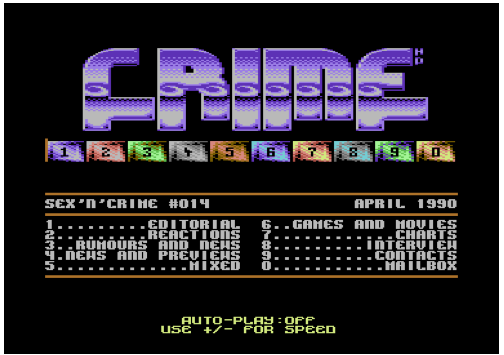
Disk magazines, or just diskmags/mags for short, are digital journals that were originally published on diskettes (hence the name). They share some common properties with their traditional printed counterparts, such as ads, sections and articles, but some features, such as their background music, distribution channels and interactive navigation spring from their digital nature. The demoscene has actively created diskmags starting from the late 1980s, and before the Internet age they could be considered as one of the most important international communication channels of the community. There were also commercial diskmags published by companies and user clubs, but they will not be discussed here.
Diskmags, quite naturally, deal with topics that are of interest to the community. There is a wide variety of content available in them: for example, the largest issues of Imphobia sported as many as 250 articles, spanning several hundreds of pages. Among the most typical topics are news, discussions about the changing field of technology, swapping ads, programming tricks, party invitations, competition results, and interviews of notable demoscene members. Back in the day the discussions were often heated, complete with wars between groups and name-calling. Charts, where people could vote for their favorite groups and productions used to be common as well. Such ranking lists serve as an example of the competitive nature of the community.

The first diskmags, such as Sex'n'Crime, were simple and contained maybe only a dozen of articles. In a few years the amount of content and the audiovisual sophistication increased considerably, and as can be seen in the second picture, the magazines on the Commodore Amiga already featured a graphical user interface and somewhat polished visual design. Towards the late nineties even more features, such as embedded images and hyperlinks were added, but eventually the rise of the Internet diminished the importance of the medium, when web-based discussion forums became popular. Not many diskmags remain active these days and even they often have a separate web version.
For an example of a contemporary magazine, see Hugi. Claus-Dieter Volko, the editor of Hugi, has written several articles on diskmags, which can be found online on his website: http://www.students.meduniwien.ac.at/~n0102122/index_articles1.htm. The early roots of Commodore 64 mags were documented by Newscopy/G*P in his online article “Differentiate or Die”: http://www.atlantis-prophecy.org/recollection/?load=online&issue=0⊂=article&id=10.

